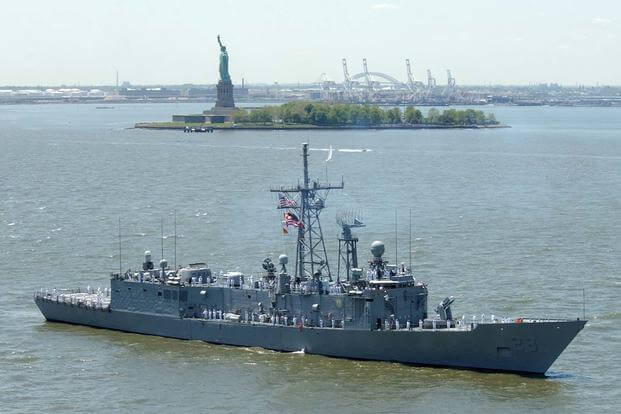Navy brass are seriously examining the possibility of pulling seven or eight of its Oliver Hazard Perry-class frigates out of retirement as the service works to surge its numbers.
Speaking Tuesday morning at a current strategy forum hosted by the U.S. Naval War College in Newport, Rhode Island, Chief of Naval Operations Adm. John Richardson said the move was under consideration, though it would likely entail significant effort to modernize the older ships.
"We've got to be thoughtful about this," he said. " ... Those are some old ships and the technology on those ships is old. And in this exponential type of environment, a lot has changed since we last modernized those. So it will be a cost-benefit analysis in terms of how we do that.
The Navy built 51 Perry-class frigates in the late 1970s and early 1980s. The era of the ships was relatively short-lived; the first of the class, the Oliver Hazard Perry, was decommissioned in 1997, after just 20 years of service. The service decommissioned the last of the class, the Simpson in 2015.
Related content:
- New World Threats Prompt Navy to Review Frigate Design
- Navy Wants Amphibs, Destroyers That Last Up to 50 Years
- Military.com's Equipment Guide: Ships
Following their decommissioning in the U.S. Navy, a number of the ships were transferred to international navies, including those of Turkey, Egypt, and Pakistan, for continued use. Others were sunk for use as diving and fishing reefs, used as targets for missile tests, or dismantled for scrap.
There are now 12 Perry-class frigates listed in the holdings of the Naval Inactive Ship Maintenance Facility, which maintains "mothball fleets" in Pearl Harbor; Philadelphia; and Bremerton, Washington. Some are marked as candidates for foreign military sale.
In a recent address at the Center for Strategic and International Studies in Washington, D.C., commander of Naval Sea Systems Command Vice Adm. Thomas Moore said ships in that era were not maintained or modernized with an eye to longevity.
"We kind of got rid of them at the 25-year point; we didn't do maintenance on them," he said. "The reality of it is, we really got rid of a lot of those ships because, from a combat systems standpoint, they had become obsolete."
That was true of the Perry-class frigates, which did not receive crucial warfighting updates and were overshadowed by the Aegis capabilities of the new Arleigh Burke-class destroyers and Ticonderoga-class cruisers. Within the Navy, some referred to the frigates as the "ghetto fleet."
It's not clear what it would take to get these ships sailing again in today's fleet or when Navy leadership will make a decision on whether or not to do so. Notably, Richardson made no mention of bringing the carrier Kitty Hawk out of mothballs as well, a possibility hinted at by Moore in a recent interview with Defense and Aerospace Report.
What is clear, however, is that relying on laid-up ships alone won't be enough to bring the Navy close to its goal of a 355-ship fleet. Richardson reiterated his goal to extend the service life of currently serving ships and making existing platforms more capable, using technologies such as directed energy weapons to get more than a ship's worth of capability out of every ship in the fleet.
"There are many types of those technologies that are out there, imaging radars, those sorts of things, to make each of these platforms more capable, delivering more naval power," he said.
-- Hope Hodge Seck can be reached at hope.seck@military.com. Follow her on Twitter at @HopeSeck.





























